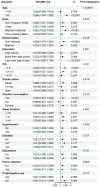Positive and linear association of hepatic steatosis index with female infertility in US women: results from the National Health and Nutrition Examination Survey 2013-2018
- PMID: 40642238
- PMCID: PMC12241013
- DOI: 10.3389/fpubh.2025.1617550
Positive and linear association of hepatic steatosis index with female infertility in US women: results from the National Health and Nutrition Examination Survey 2013-2018
Abstract
Background: Female infertility is a global reproductive health challenge. The hepatic steatosis index (HSI) is a simple and non-invasive screening tool for steatosis. We herein explore the association of HSI with female infertility through the National Health and Nutrition Examination Survey (NHANES) 2013-2018.
Methods: This cross-sectional study included 2,133 reproductive-age women from 15 U.S. states, with data collected through standardized questionnaires, physical examinations, and laboratory tests across three survey cycles (2013-2018). HSI was assessed based on body mass index, ALT/AST, sex, and diabetes status. Female infertility status was ascertained through standardized questionnaire items reflecting clinical diagnostic criteria (≥1 year of unprotected intercourse without conception), though not verified by medical records or fertility testing. Multivariable logistic regression analysis was used to explore the association between HSI and female infertility and to calculate the odds ratio (OR) and 95% confidence interval (CI). Restricted cubic spline (RCS) and stratified analyses were further employed to examine potential nonlinear relationships and subgroup disparities. Explored the factors affecting HSI through multivariate analysis.
Results: A total of 2,133 reproductive-age women were enrolled, of whom 271 had infertility. There was no significant trend in HSI levels across cycles. In the fully adjusted model, HSI showed positive cross-sectional associations with self-reported infertility status (OR 1.02, 95% CI 1.01-1.04, p = 0.005). Compared to Q1, HSI at Q4 was associated with a 72% increase in the odds of female infertility (p = 0.003). Restricted cubic spline (RCS) analysis indicated that this association was linear (p for nonlinear = 0.9698). Stratified analyses suggested that this association was more pronounced among those <35 years of age and those with <high school education. RCS analyses based on age subgroups similarly indicated that this association was significant and linear among participants <35 years.
Conclusion: HSI was positively associated with the odds of female infertility and demonstrated a linear dose-response association. These findings suggest that HSI may be used as an potential marker to screen reproductive age women at high risk of infertility, although further research is needed to validate its predictive utility and clinical applicability.
Keywords: NHANES; female infertility; hepatic steatosis index; reproductive health; steatosis.
Copyright © 2025 Wu, Zhang and Wu.
Conflict of interest statement
The authors declare that the research was conducted in the absence of any commercial or financial relationships that could be construed as a potential conflict of interest.
Figures




Similar articles
-
A New Measure of Quantified Social Health Is Associated With Levels of Discomfort, Capability, and Mental and General Health Among Patients Seeking Musculoskeletal Specialty Care.Clin Orthop Relat Res. 2025 Apr 1;483(4):647-663. doi: 10.1097/CORR.0000000000003394. Epub 2025 Feb 5. Clin Orthop Relat Res. 2025. PMID: 39915110
-
The relationship between flavonols intake and stroke in the elderly: a cross-sectional study from NHANES (2007-2010 and 2017-2018).J Stroke Cerebrovasc Dis. 2025 Aug;34(8):108373. doi: 10.1016/j.jstrokecerebrovasdis.2025.108373. Epub 2025 Jun 7. J Stroke Cerebrovasc Dis. 2025. PMID: 40490174
-
Racial and ethnic disparities in fecundability: a North American preconception cohort study.Hum Reprod. 2025 Jun 1;40(6):1183-1194. doi: 10.1093/humrep/deaf067. Hum Reprod. 2025. PMID: 40246287
-
Antioxidants for male subfertility.Cochrane Database Syst Rev. 2022 May 4;5(5):CD007411. doi: 10.1002/14651858.CD007411.pub5. Cochrane Database Syst Rev. 2022. PMID: 35506389 Free PMC article.
-
Antioxidants for female subfertility.Cochrane Database Syst Rev. 2013 Aug 5;(8):CD007807. doi: 10.1002/14651858.CD007807.pub2. Cochrane Database Syst Rev. 2013. Update in: Cochrane Database Syst Rev. 2017 Jul 28;7:CD007807. doi: 10.1002/14651858.CD007807.pub3. PMID: 23913583 Updated.
References
MeSH terms
LinkOut - more resources
Full Text Sources
Medical

